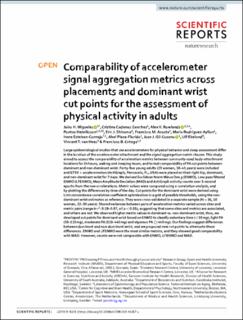| dc.contributor.author | Migueles, Jairo H. | |
| dc.contributor.author | Cadenas-Sanchez, Cristina | |
| dc.contributor.author | Rowlands, Alex V. | |
| dc.contributor.author | Henriksson, Pontus | |
| dc.contributor.author | Shiroma, Eric | |
| dc.contributor.author | Acosta, Francisco M. | |
| dc.contributor.author | Rodriguez-Ayllon, Maria | |
| dc.contributor.author | Esteban-Cornejo, Irene | |
| dc.contributor.author | Plaza-Florido, Abel | |
| dc.contributor.author | Gil-Cosano, Jose J. | |
| dc.contributor.author | Ekelund, Ulf | |
| dc.contributor.author | van Hees, Vincent T. | |
| dc.contributor.author | Ortega, Francisco B. | |
| dc.date.accessioned | 2020-05-13T09:29:05Z | |
| dc.date.available | 2020-05-13T09:29:05Z | |
| dc.date.created | 2020-02-03T11:48:51Z | |
| dc.date.issued | 2019 | |
| dc.identifier.citation | Scientific Reports. 2019, 9(1), 18235. | en_US |
| dc.identifier.issn | 2045-2322 | |
| dc.identifier.uri | https://hdl.handle.net/11250/2654197 | |
| dc.description | This article is licensed under a Creative Commons Attribution 4.0 International License, which permits use, sharing, adaptation, distribution and reproduction in any medium or format, as long as you give appropriate credit to the original author(s) and the source, provide a link to the Creative Commons license, and indicate if changes were made. Te images or other third party material in this article are included in the article’s Creative Commons license, unless indicated otherwise in a credit line to the
material. If material is not included in the article’s Creative Commons license and your intended use is not permitted by statutory regulation or exceeds the permitted use, you will need to obtain permission directly from the copyright holder. To view a copy of this license, visit http://creativecommons.org/licenses/by/4.0/. | en_US |
| dc.description.abstract | Large epidemiological studies that use accelerometers for physical behavior and sleep assessment difer in the location of the accelerometer attachment and the signal aggregation metric chosen. This study aimed to assess the comparability of acceleration metrics between commonly-used body-attachment locations for 24hours, waking and sleeping hours, and to test comparability of PA cut points between dominant and non-dominant wrist. Forty-fve young adults (23 women, 18–41 years) were included and GT3X+accelerometers (ActiGraph, Pensacola, FL, USA) were placed on their right hip, dominant, and non-dominant wrist for 7 days. We derived Euclidean Norm Minus One g (ENMO), Low-pass fltered ENMO (LFENMO), Mean Amplitude Deviation (MAD) and ActiGraph activity counts over 5-second epochs from the raw accelerations. Metric values were compared using a correlation analysis, and by plotting the diferences by time of the day. Cut points for the dominant wrist were derived using Lin’s concordance correlation coefcient optimization in a grid of possible thresholds, using the nondominant wrist estimates as reference. They were cross-validated in a separate sample (N=36, 10 women, 22–30 years). Shared variances between pairs of acceleration metrics varied across sites and metric pairs (range in r2: 0.19–0.97, all p<0.01), suggesting that some sites and metrics are associated, and others are not. We observed higher metric values in dominant vs. non-dominant wrist, thus, we developed cut points for dominant wrist based on ENMO to classify sedentary time (<50mg), light PA (50–110mg), moderate PA (110–440mg) and vigorous PA (≥440mg). Our fndings suggest diferences between dominant and non-dominant wrist, and we proposed new cut points to attenuate these diferences. ENMO and LFENMO were the most similar metrics, and they showed good comparability with MAD. However, counts were not comparable with ENMO, LFENMO and MAD. | en_US |
| dc.language.iso | eng | en_US |
| dc.subject | epidemiology | en_US |
| dc.subject | occupational health | en_US |
| dc.title | Comparability of accelerometer signal aggregation metrics across placements and dominant wrist cut points for the assessment of physical activity in adults | en_US |
| dc.type | Peer reviewed | en_US |
| dc.type | Journal article | en_US |
| dc.description.version | publishedVersion | en_US |
| dc.rights.holder | © The Author(s) 2019. | en_US |
| dc.source.pagenumber | 1-12 | en_US |
| dc.source.volume | 9 | en_US |
| dc.source.journal | Scientific Reports | en_US |
| dc.source.issue | 1 | en_US |
| dc.identifier.doi | 10.1038/s41598-019-54267-y | |
| dc.identifier.cristin | 1790133 | |
| dc.description.localcode | Seksjon for idrettsmedisinske fag / Department of Sports Medicine | en_US |
| cristin.ispublished | true | |
| cristin.fulltext | original | |
| cristin.qualitycode | 1 | |
